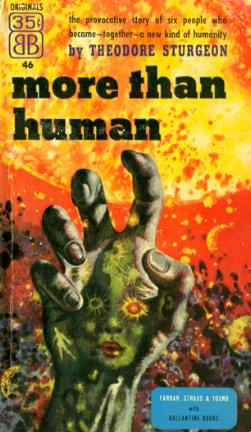"More Than Human" by Theodore Sturgeon
 Heinlein, Asimov, and Clarke hog the spotlight for channeling the optimism of modernism into fiction. Kings of the Silver Age, their stories feature squeaky clean space modules where every pipe, switch, and console functions as it should, scientists with nothing but altruism for the human race at heart, and a no-situation-can’t-be-overcome attitude toward engineering and problem solving. The hope space offered was on their, and the Western world’s mind. Falling in these writers’ shadows were those who utilized other burgeoning subjects du jour. Parapsychology something many were equally optimistic about, it features in numerous works of the era. Alfred Bester put it to wide use, as did Jack Vance, Frederik Pohl, Phillip K. Dick, Harry Harrison, (early) Robert Silverberg, and others toward telling stories of the mentally possible, and in turn popularizing the idea. But the pinnacle of psi-power’s sanguinity is certainly Theodore Sturgeon’s More Than Human. A undeniably modernist statement from the perspective of parapsychology, the novel's premise sags beneath the weight of time but remains powerful for the high quality prose and transcendence of traditional mores.
Heinlein, Asimov, and Clarke hog the spotlight for channeling the optimism of modernism into fiction. Kings of the Silver Age, their stories feature squeaky clean space modules where every pipe, switch, and console functions as it should, scientists with nothing but altruism for the human race at heart, and a no-situation-can’t-be-overcome attitude toward engineering and problem solving. The hope space offered was on their, and the Western world’s mind. Falling in these writers’ shadows were those who utilized other burgeoning subjects du jour. Parapsychology something many were equally optimistic about, it features in numerous works of the era. Alfred Bester put it to wide use, as did Jack Vance, Frederik Pohl, Phillip K. Dick, Harry Harrison, (early) Robert Silverberg, and others toward telling stories of the mentally possible, and in turn popularizing the idea. But the pinnacle of psi-power’s sanguinity is certainly Theodore Sturgeon’s More Than Human. A undeniably modernist statement from the perspective of parapsychology, the novel's premise sags beneath the weight of time but remains powerful for the high quality prose and transcendence of traditional mores.Now perceived as more fantasy than science fiction (an interesting transition considering the material itself underwent no change), More Than Human is the story of the oddest of odd humans and their drawing together to become something more. Opening in fairy tale tone, the reader is introduced to the “fabulous idiot” and the trials of life (and love) he must go through to be functionally independent. A trio of young girls eventually finding their way to his forest home, the idiot doesn’t bat an eye learning one is telekinetic and the other two—twins, in fact—can teleport at will. But finding a baby left behind by a farmer turns out to be the game changer. A catalyst binding the bizarre group together, they are now equipped to revolutionize society. Whether they know it or not, however, is another story.
Due to its dependence on teleporting, telekinesis, telepathy and all other manner of “psionics”, the colors of More Than Human have faded as its ideas lose their scientific rigor—particularly as Sturgeon seems to depend on them in singular circumstances. Not helping is another dependence: traditional psychoanalysis. This is not to say the practice has no value, only that the manner in which Sturgeon employs it has all the markings of the day, including breakthroughs magically revealed, archetypal false memories, etc. As such, the book must be approached symbolically if any interest is to be invested.
Bonnie and Beanie African American (teleporting) twins, Janie a (telekinetic, telepathic) intelligent young girl from a broken home, and Baby a mysterious entity (super brain) with wheels spinning in its irises (see the cover), the gestalt the group comes to exist as can be read at the superficial level as a coincidental meeting of exceptional talents whose sum is greater than its parts. That perspective difficult to suspend enough disbelief to overcome, it’s also possible to take a broader view and see them as representative of the hope for society as of the mid 20 th century. Blacks and whites more disparate in the ‘50s, race was a matter only beginning to resolve itself; gender not balanced, women were only starting to gain equality; and religion, still quite dominate, was more often an irrationally restrictive influence. Sturgeon overrides these mindsets to amalgamate the characters and social contexts into a functioning whole. (Delany accomplished something similar in Babel-17.) If the reader ignores the cheesy psychology and mind powers which superficially bind these pieces together, the social facets of the group that forms are as variegated socially as can be yet form a holistic whole—which plays into the hands of modern liberalism better than a lot of texts from the era.
Given the third and final section of the book is titled simply “Morality”, one perceives Sturgeon was looking to see this creation progress the society the characters were innate to. Looking at this sub-strata of the text, the novel can be respected.
In the end, More Than Human has the potential to be extremely divisive for the modern reader. Many of the devices the story depends upon—parapsychology and traditional psychoanalytics—have largely been usurped or discounted by modern practice and knowledge. But to discard the book entirely for this would be do it a disservice and ignore an important aspect of science fiction, if not American history. Sturgeon’s usage of anachronistic devices is wholly optimistic in its view that humanity is able to transcend its defects—social and personal—to become something more socially functionable. The prose at times incredibly tactile (M. John Harrison calls it “Wild talents, dark forces.” and Brian Aldiss “Sturgeon’s caviar dish.”), the novel should be looked upon as a sample of science fiction’s contribution to modernist literature—for all that entails. (Jesse, Speculiction)

Comments
Post a Comment